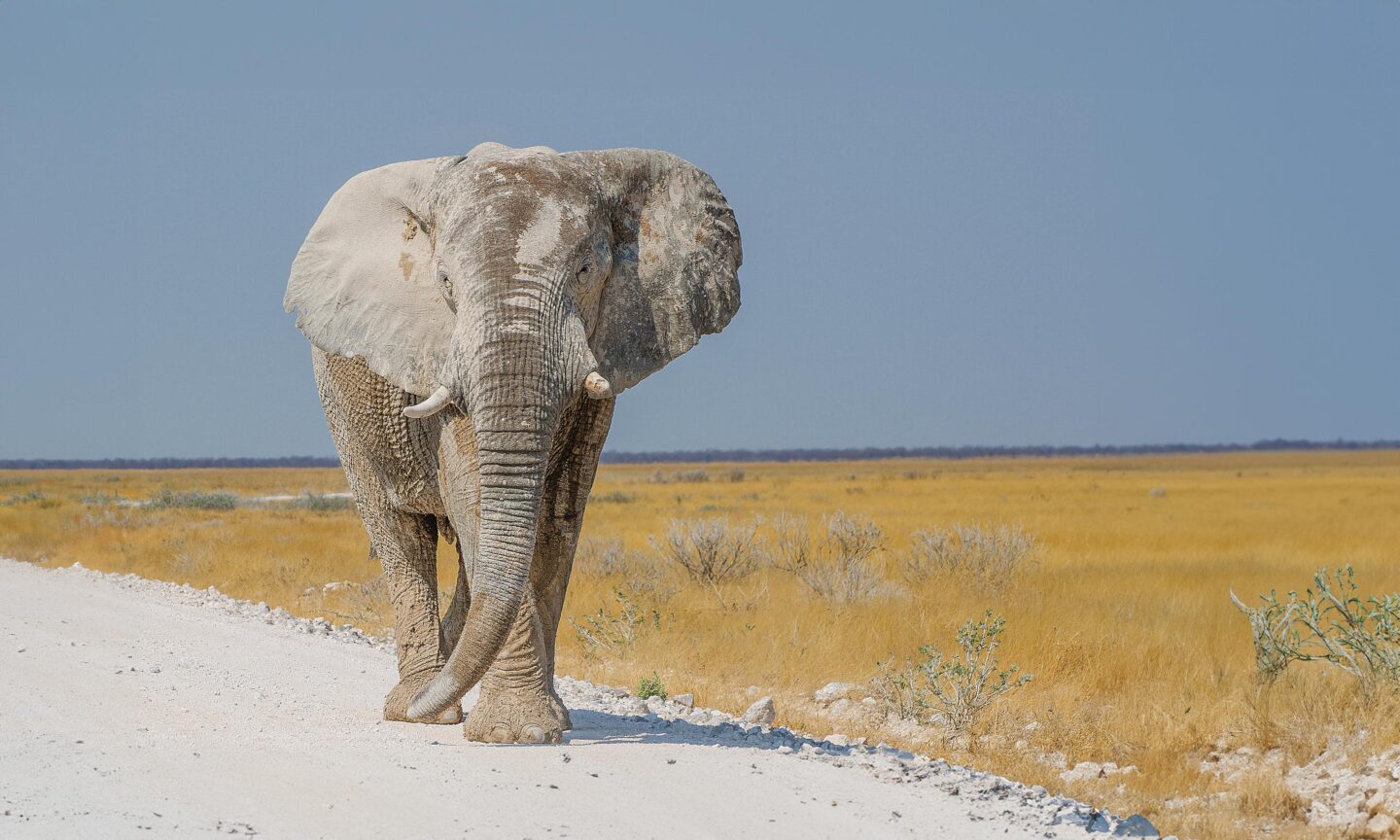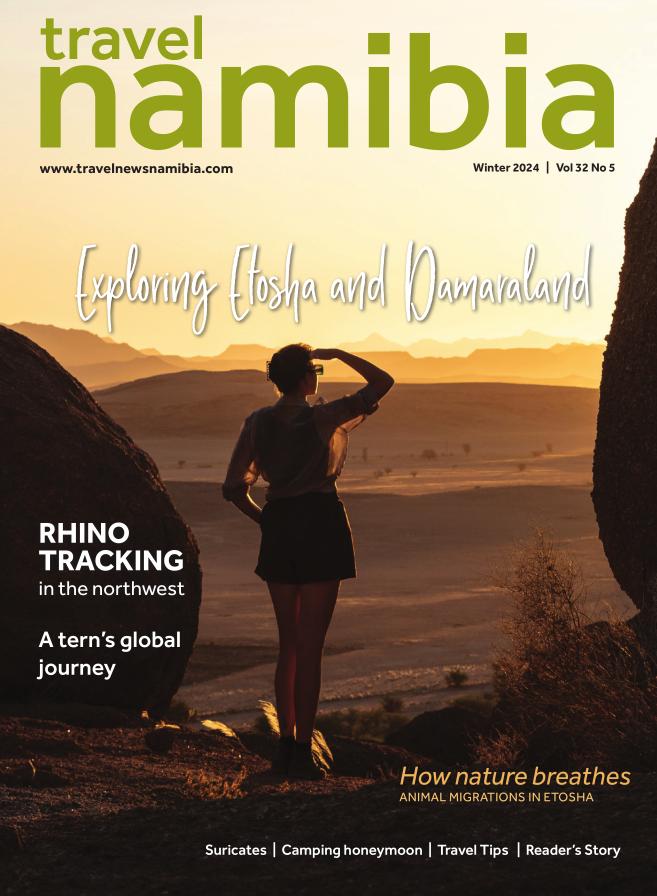

Exploring Animal Movements:
UNRAVELLING THE
RHYTHMS OF THE WILD
Can a landscape exhale and inhale with the ebb and flow of life? Do animals adjust their movement patterns in response to shifts in resource availability? These fundamental questions regarding the characteristics of wilderness also extend to fenced areas and national parks. The evidence unequivocally confirms that animals pay little heed to man- made borders, whether they be physical fences or legally designated boundaries.
Text Kirsty Watermeyer | Photographs Morgan Hauptfleisch
From the Winter 2024 issue

For over three years, a multidisciplinary team comprising students, scientists, economists and conservationists have been investigating animal movements and migratory patterns in and around Etosha National Park. Leveraging cutting-edge technology and deploying satellite trackers on over 70 animals of different species, they are unravelling a research-backed understanding of these animals’ movements and the extent to which they are constrained by boundaries. Astonishingly, their findings reveal that animals are not bound by these barriers. Associate Professor Morgan Hauptfleisch, from the Nature Conservation Department within the Natural Resource Sciences at Namibia University of Science and Technology, elucidates, “In just one month, with cameras along three known movement corridors, we recorded 11,000 movements across fences and boundaries, including through the red, or veterinary, line.”
THE IMPACT OF FENCES
Their research highlights the fact that fences fragment habitats, alter environments and pose risks of injury and mortality to wildlife, hindering their movement across landscapes. Meanwhile, the breaches in the fence are observed to provide substantial advantages to wildlife, moderating grazing pressure across regions, mitigating ecosystem degradation and enhancing genetic diversity as herds interact with diverse mating partners.
Morgan explains that these movements are vital for the animals’ survival and well-being and that with the added pressure of climate change, suitable feeding grounds are shifting beyond park boundaries, magnifying the need to move across boundaries. In a dry landscape, the animals constantly seek out water and food to sustain themselves. The concept of demarcating areas to restrict movement is foreign to animals; to them, movement is as intrinsic and instinctual as breathing.
“When the animals breed, their numbers go up and they need more space. In one example we were tracking eland, kudu and springbok. We tracked them over time and would see them hanging out in one small area around a waterhole. Then they would suddenly move with purpose, migrating up to 100 kilometres in three days and what we found was that, without exception, the spots they would move to offered them grazing with 30% more energy than where they had been before. They instinctively know exactly where to go. What we also found was that they do not just move after rains; it is not a seasonal migration that drives these decisions.”
A DANCE OF MOVEMENT
With an infectious grin, this enthusiastic scientist eagerly shares his data, allowing you to witness the precise routes and tracks of individual animals. Among them are elephants traversing between Etosha National Park and Etosha Heights, one of Namibia’s largest private reserves, which shares a 65-kilometre- long boundary with the park. Morgan reveals that these collared animals exhibit such extensive movement that one might anticipate them using the park’s entrance gate. However, surprisingly, they are not. Instead, they are breaking through fences, performing a mesmerising dance of movement across landscapes and boundaries, as depicted on Morgan’s screen.
With each fence breakage, there is a heightened risk of injury to the animals, necessitating replacement at a cost to the Ministry of Environment, Forestry and Tourism. Morgan emphasises the frequency of these incidents, recounting a recent episode where an elephant bull was entangled in wire, which prompted immediate action. “It happens all the time,” he laments. “Because it’s the red line that gets broken, by law it has to be fixed. It’s a constant cycle of repair due to frequent breaches. Now, on the southern boundary, they’ve established a breathing buffer to mitigate these issues.”
Turning to his computer, Morgan selects a single example, one elephant, to underscore his point. “If you examine the data and quantify the number of fences breached over the course of a year, this particular elephant herd made a staggering 144 breaches between the park and commercial farms, many of them of the veterinary cordon fence.”
The veterinary cordon fence, also known as the red line, is a pest-exclusion fence that serves as a delineation between northern Namibia and the central and southern regions. Originally established as a political demarcation boundary in 1907, the red line carries significant historical weight, deeply intertwined with Namibia’s colonial past. Historically, the northern areas were predominantly subject to indirect colonial rule through traditional authorities. Over time, the line has shifted, with an actual fence eventually erected in the early 1960s to contain outbreaks of foot and mouth disease in the north from spreading to the farms in the south. Today, the red line plays a pivotal role, granting Namibia its unique status to export meat across the European Union.

ADVOCATING FOR CHANGE
Morgan is optimistic about the potential of this research to drive change in outdated rules and regulations. “There may be a need for policy change,” he asserts. “Currently, we’re analysing this data from an economic perspective. What is the economic cost benefit of either establishing migration corridors along the red line or removing it altogether? We can leverage this information to advocate for policy reform,” Morgan explains, emphasising the importance of raising awareness among policymakers, particularly within the European Union (EU). “I have worked with renowned wildlife veterinarian Dr Mark Jago for many years, and he believes that if the EU understood the impact of their policies on wildlife, they may be inclined to revise them.” Morgan adds that the team has already published this information, making it public knowledge. “With our wealth of empirical data and the EU’s stringent environmental regulations, we have the opportunity to demonstrate how their current policies are causing significant environmental harm, prompting them to reconsider which measures are most ideal to control livestock disease while reducing effects on wildlife and conservation.”
THE PULSE OF ECOSYSTEMS
In regions characterised by semi-arid climates and erratic rainfall patterns, the migratory behaviour of large herbivores emerges as a vital strategy for survival, allowing them to access resources across vast territories. Namibia boasts vast free- roaming wildlife populations, including the largest free-roaming population of black rhinos in Africa and the world’s largest cheetah population. Perhaps it is time we initiate conversations regarding the migration and movements of animals across this vast landscape.
“Across Africa, the expansion opportunities for elephants are becoming less. We have expansion opportunities. This is what has happened at Etosha Heights – it created a mini Etosha with this semi-open system. This could be just the beginning. There is a massive opportunity for increasing conservation land with commercial farms by connecting them. In the areas outside of the park you either find a communal conservancy or a private farm. Some have converted to wildlife, but others are still farming cattle in an area where the vegetation and rainfall make commercial farming extremely hard.”
EMBRACING THE RHYTHMS OF LIFE
Morgan elaborates on the seasonal breeding patterns of Etosha, highlighting the additional strain it places on the park’s boundaries. “Expansion is beneficial for a park; breathing is beneficial for a park,” he asserts. “In regions where fences have been removed and animals are permitted to roam freely, we observe benefits that extend to the entire ecosystem.”
As ecosystems breathe, they thrive. In the rhythmic dance of migration, ecosystems pulse with vitality, nurturing the interconnected web of existence. Just like the lungs of the planet, they expand and contract, responding to the natural rhythms of life. By allowing wildlife the freedom to move, ecosystems flourish, fostering biodiversity, resilience and harmony. What we are beginning to realise, is that this breath underscores the ebb and flow of movement that lies at the heart of all life on Earth. TN
This research is made possible by the GIZ, the German Ministry of Education and Research as well as Etosha Heights.






